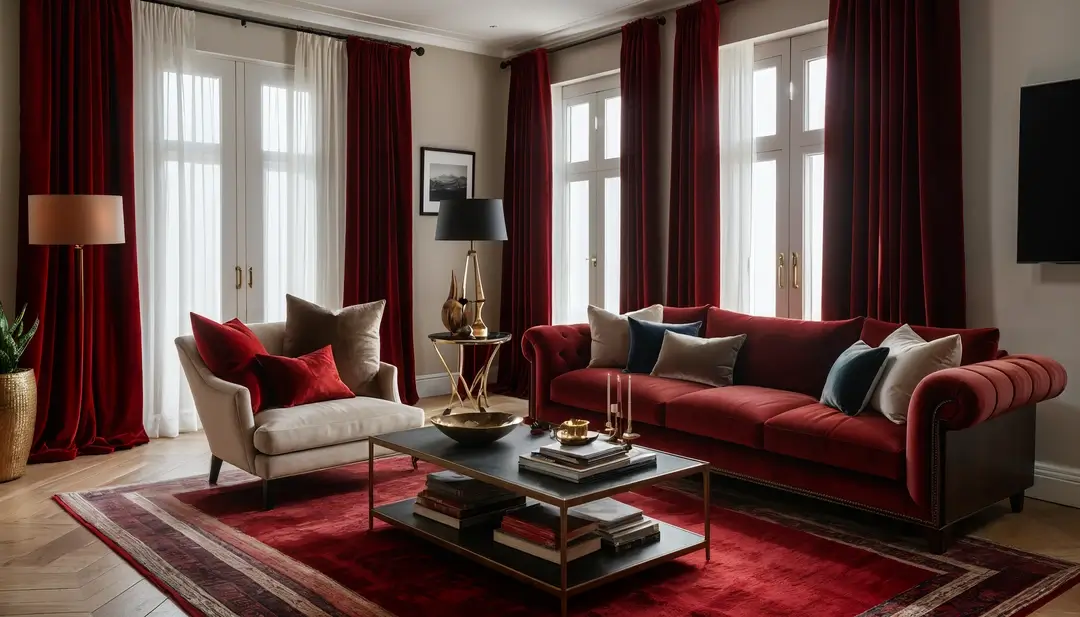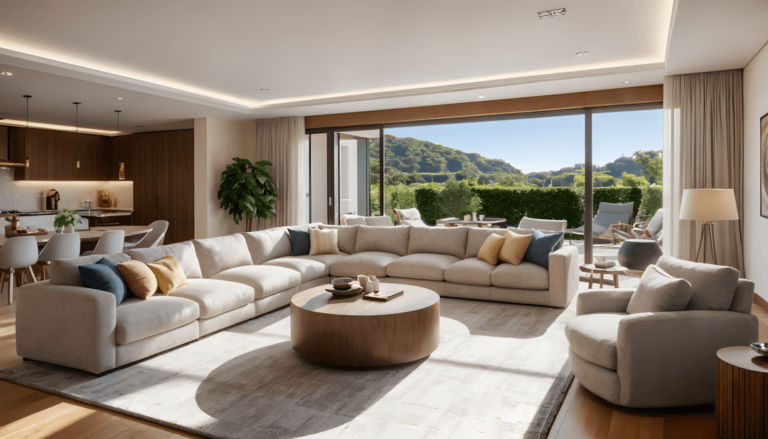In my experience working with homeowners on living room designs, I’ve observed that red rugs often serve as powerful design elements that can transform spaces through their warmth and visual impact. Through various projects, I’ve learned that this bold color choice typically works well when balanced carefully with surrounding elements, creating environments that feel both energetic and sophisticated.
Note: For any structural modifications, electrical work, or installations mentioned in this article, always consult with licensed professionals to ensure safety and code compliance.
What makes red rugs particularly effective in interior design is their ability to serve as focal points while adding warmth that many homeowners find appealing. I’ve found that homeowners often choose red rugs because they typically create immediate visual impact while remaining versatile enough to work with various decorating styles. The key often lies in understanding how to balance the rug’s intensity with complementary elements.
Here are 25 approaches for incorporating red rugs into living rooms that often work well in different home environments, based on observations from various design projects.
1. Neutral Wall Balance Strategy
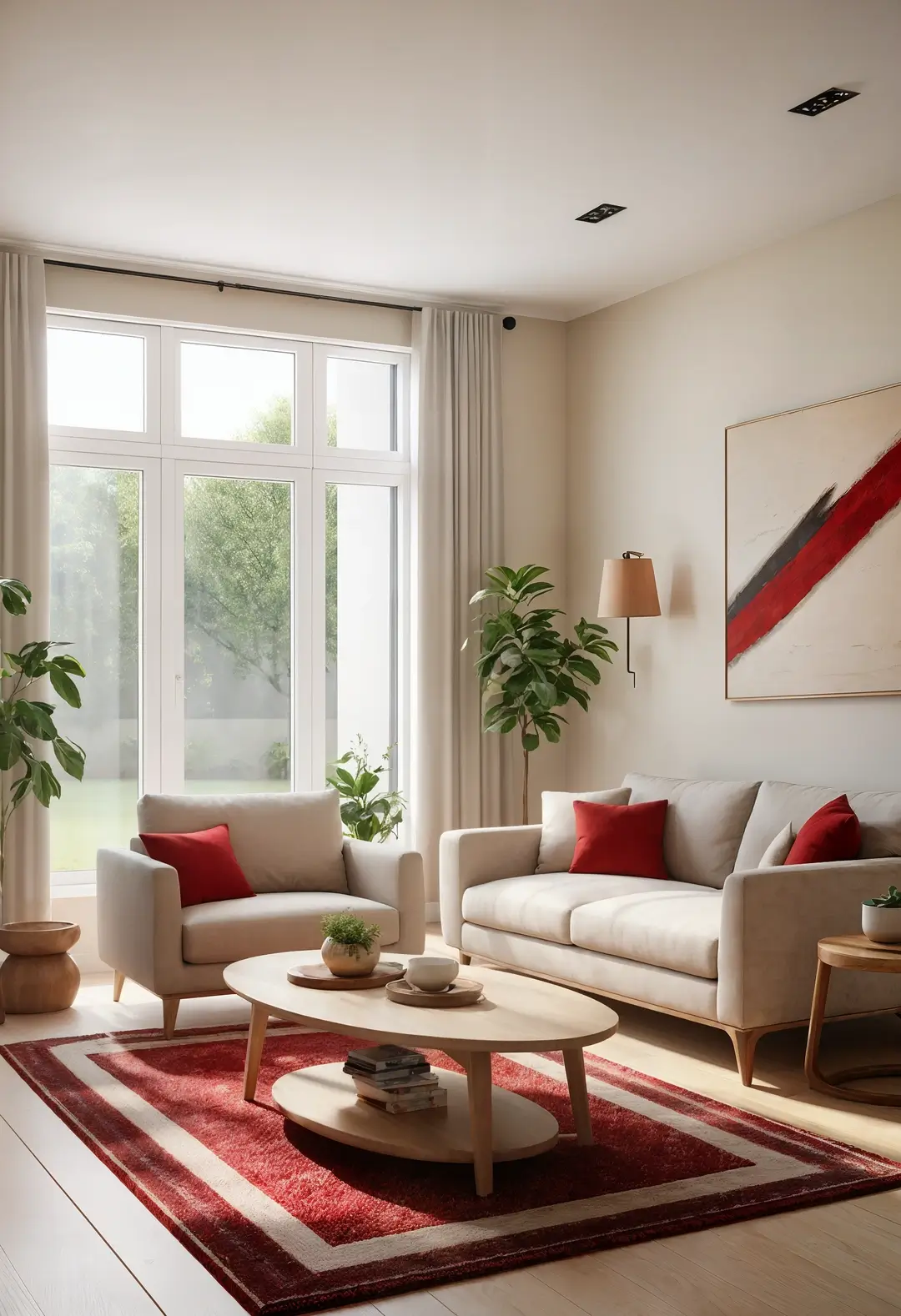
This foundational approach often appeals to homeowners wanting to highlight their red rug without overwhelming the space. Using neutral walls in white, beige, or light gray typically allows the rug’s vibrant color to take prominence while maintaining visual balance.
Design consideration: Soft, muted wall colors often provide the perfect backdrop for red rugs to shine without creating visual competition.
Practical benefit: This strategy often creates sophisticated environments that feel both bold and refined.
2. Cool Tone Contrast Technique
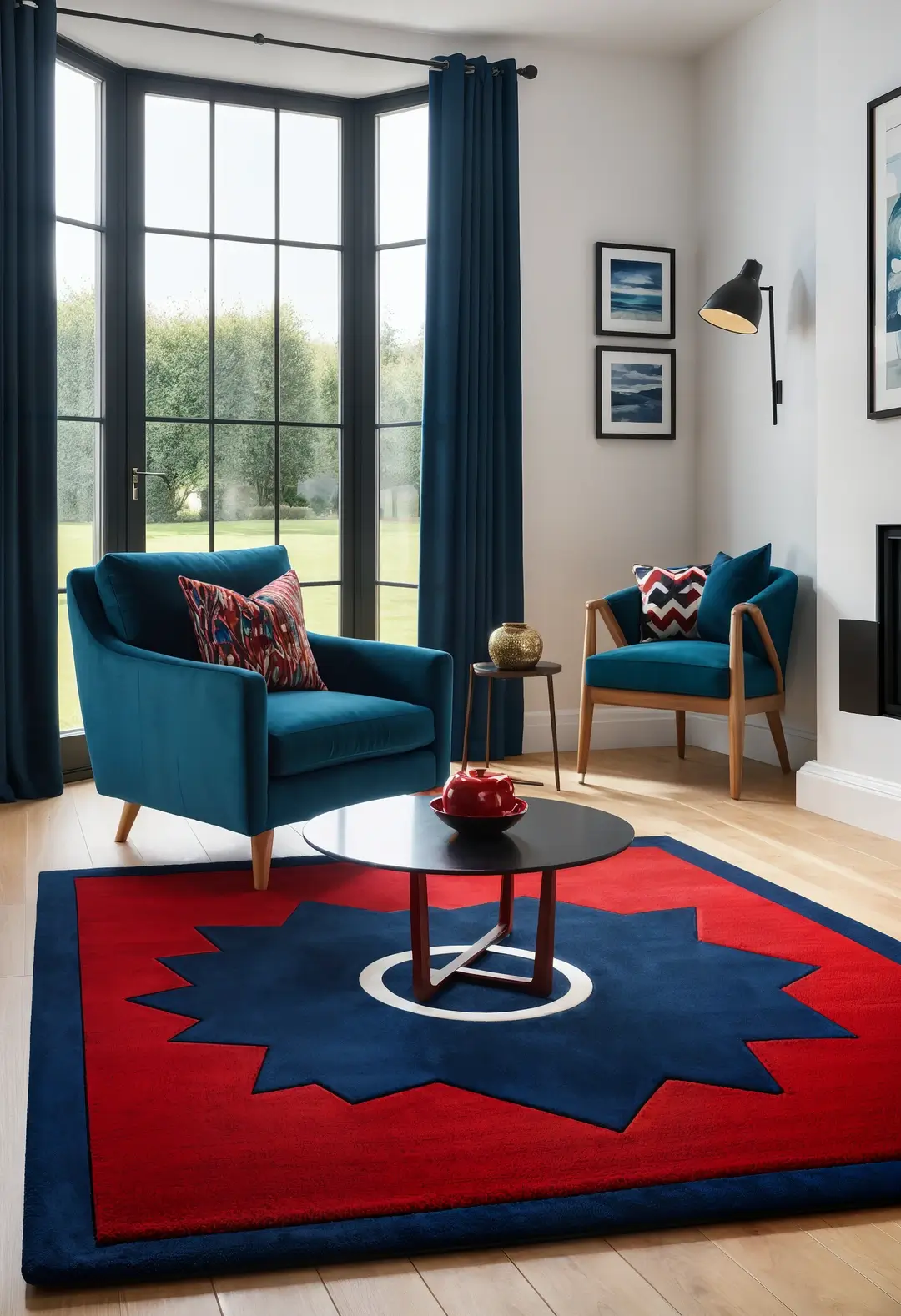
This dynamic approach often works well for homeowners seeking visually striking environments. Pairing red rugs with cool colors like navy blue, teal, or charcoal gray typically creates compelling contrast that adds depth and visual interest.
Color theory: The warm-cool contrast often creates natural harmony while allowing both color families to enhance each other.
Design application: Cool-toned accent pieces like pillows or chairs often provide effective balance against red rug foundations.
3. Scandinavian Minimalist Integration
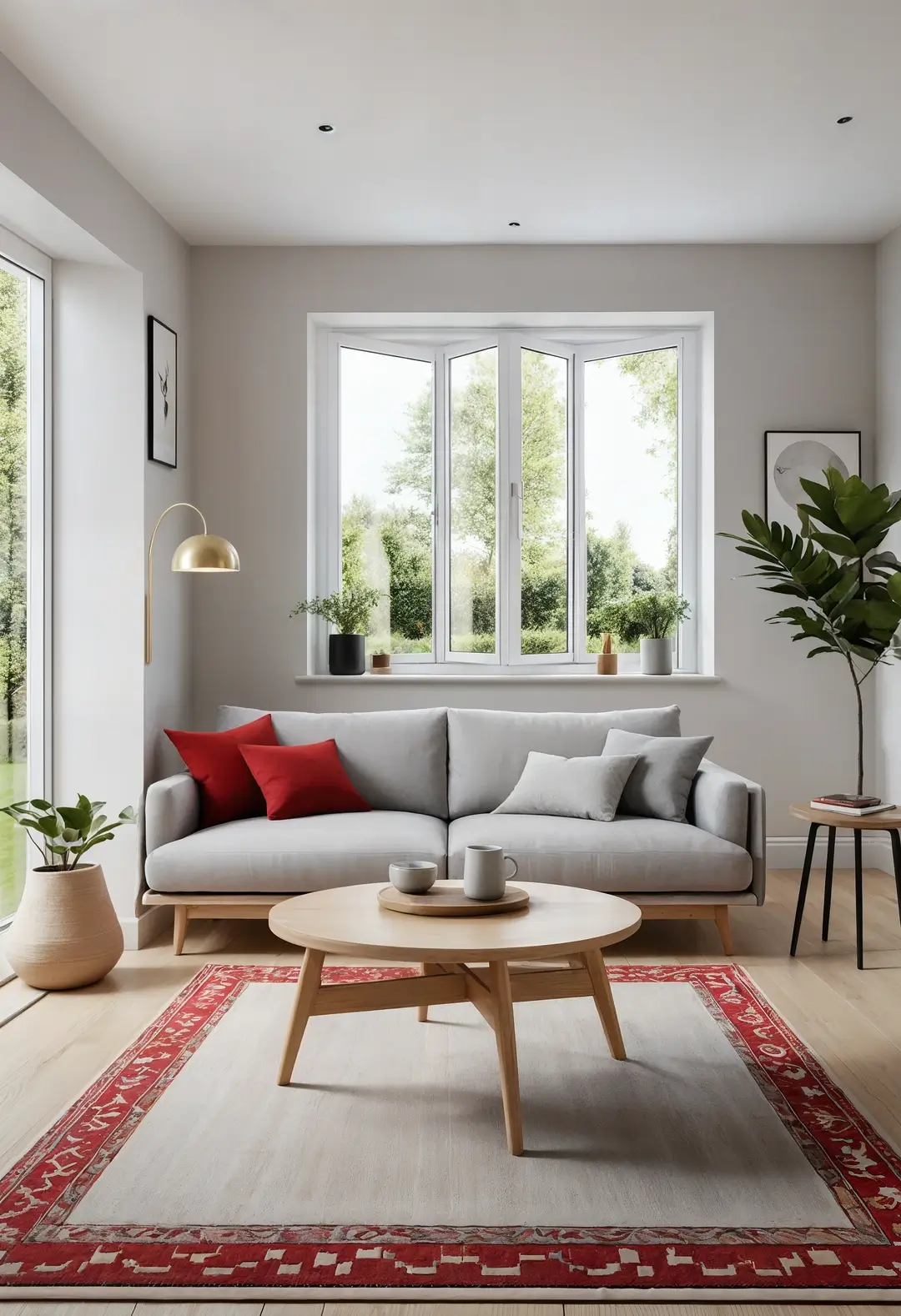
This clean approach often appeals to homeowners who appreciate simplicity while wanting color impact. Light-colored, minimalist furniture typically complements red rugs by providing visual calm around the bold focal point.
Design principle: Simple, functional pieces often allow the rug’s color and pattern to take center stage without creating visual chaos.
What makes this effective: The combination often creates sophisticated contrast between bold color and clean lines.
4. Metallic Accent Enhancement
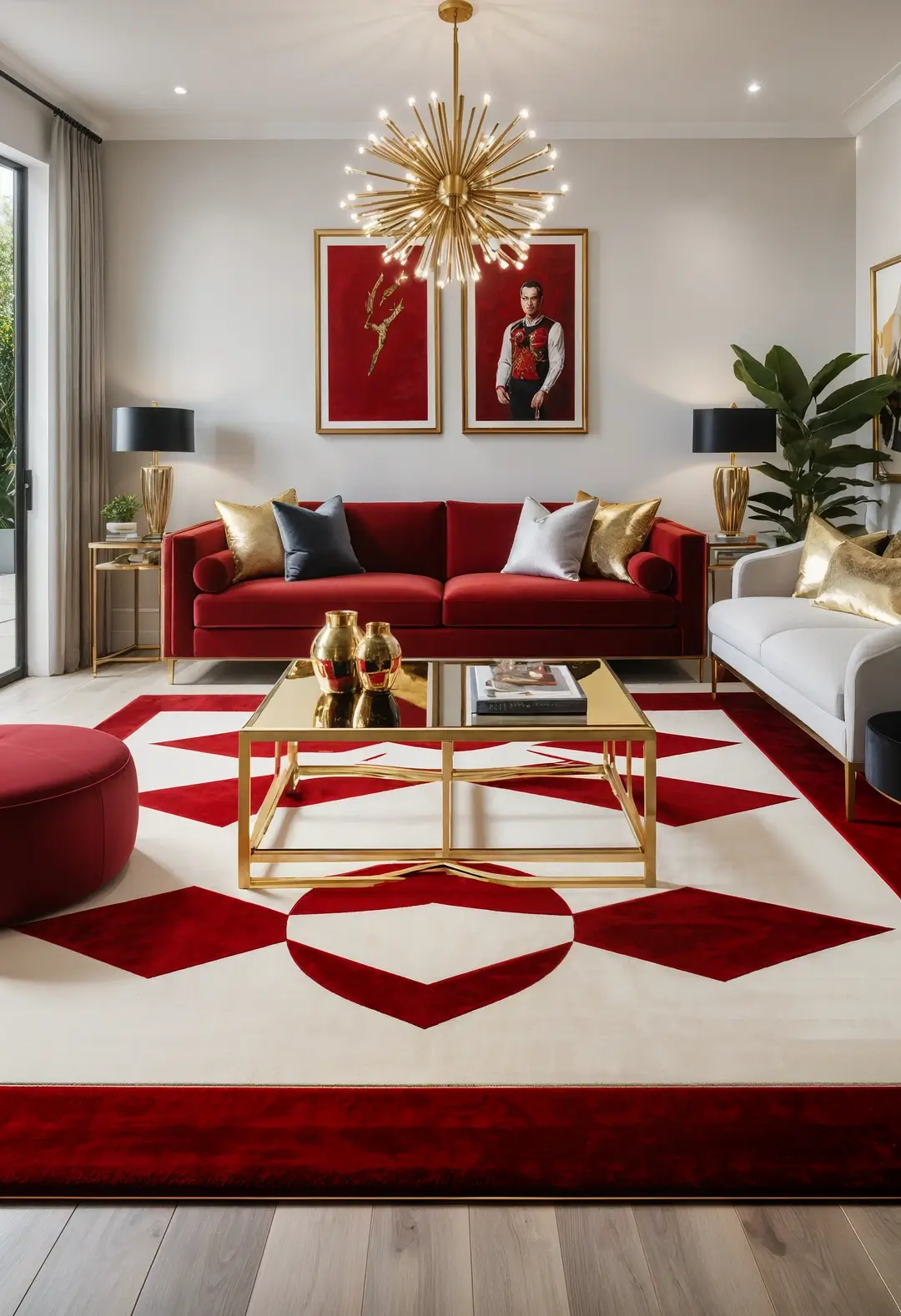
This luxurious approach often works well for homeowners seeking sophisticated, upscale environments. Gold, brass, or silver accessories typically complement red rugs while adding reflective elements that enhance the overall richness.
Design benefit: Metallic finishes often provide elegant contrast against red’s warmth while adding light and sophistication to the space.
Practical consideration: Strategic metallic placement through frames, lamps, or tables often creates cohesive luxury without overwhelming the design.
5. Vintage Element Combination
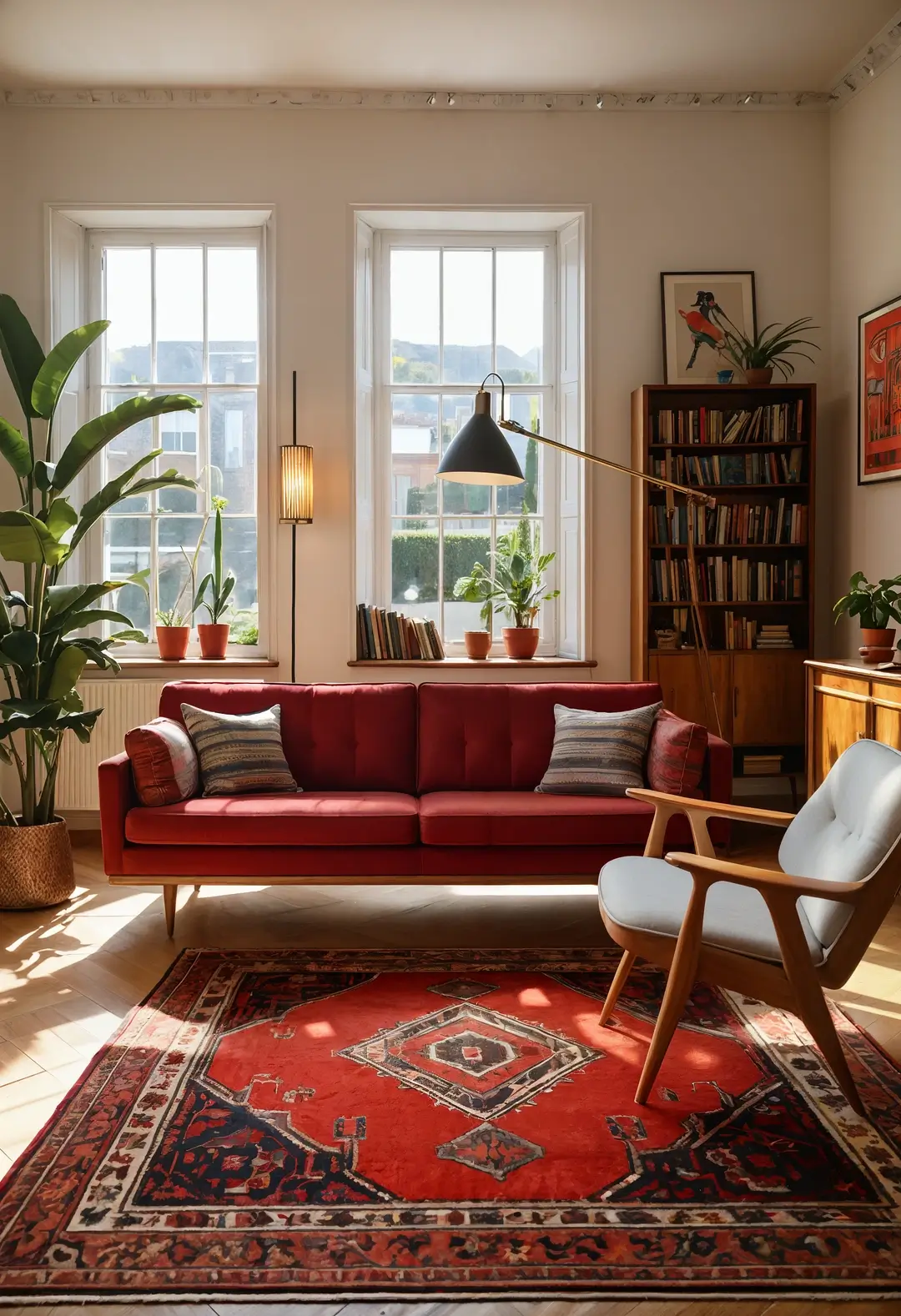
This characterful approach often appeals to homeowners who appreciate eclectic, collected aesthetics. Vintage or antique furniture with red rugs typically creates layered environments that feel both timeless and intentionally curated.
Design harmony: Both elements often share rich character qualities that create natural compatibility and authentic charm.
What enhances this style: The combination often allows for personal expression while maintaining sophisticated foundations.
6. Neutral Furniture Foundation
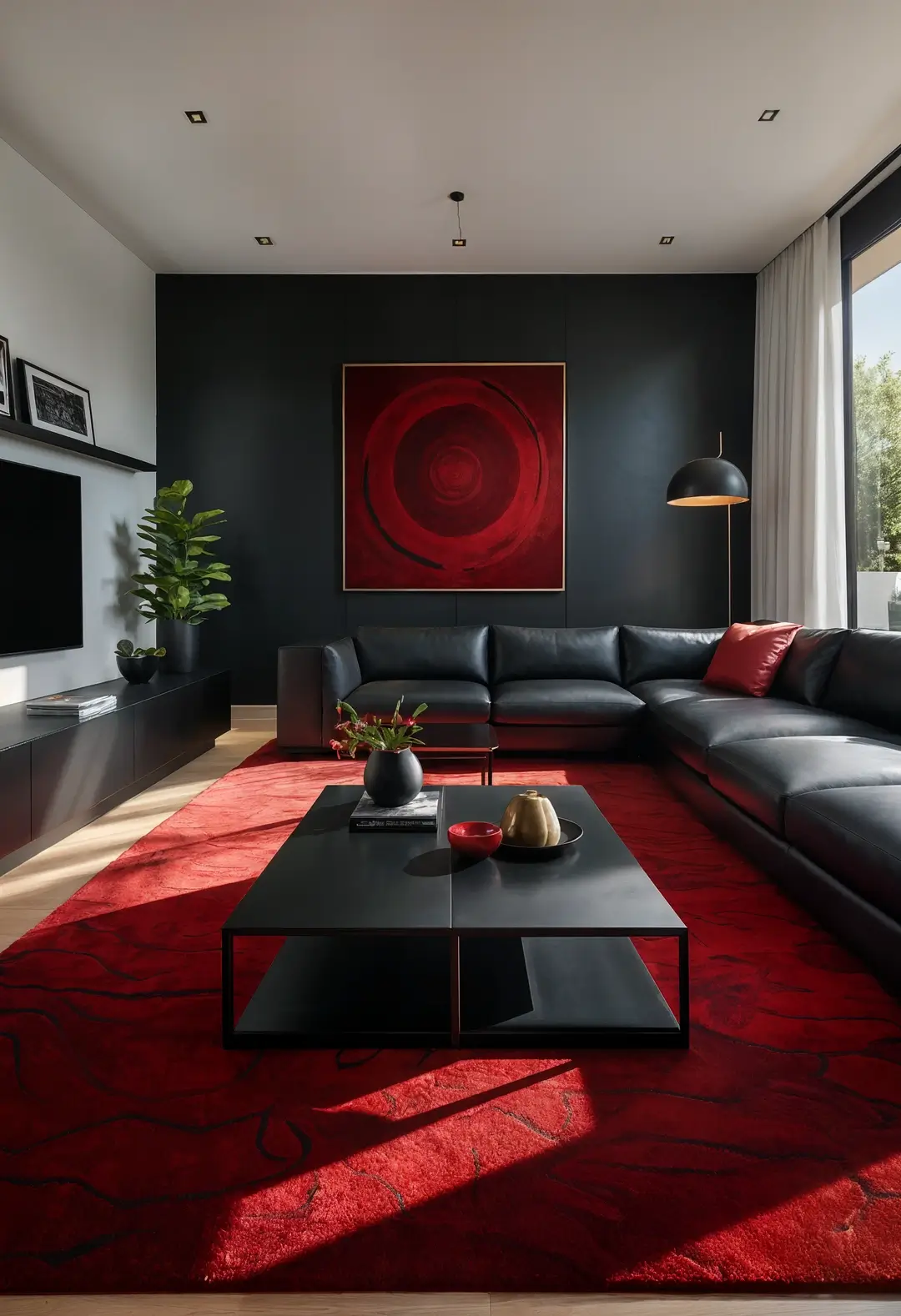
This balanced approach often works well for homeowners preferring understated elegance. Light gray, beige, or taupe furniture typically provides calm backdrops that allow red rugs to become natural focal points.
Design strategy: Neutral furniture often prevents color competition while ensuring the rug receives appropriate visual attention.
Practical benefit: This approach often allows for easy seasonal decorating changes through accessories while maintaining the rug as a consistent anchor.
7. Black Accent Sophistication
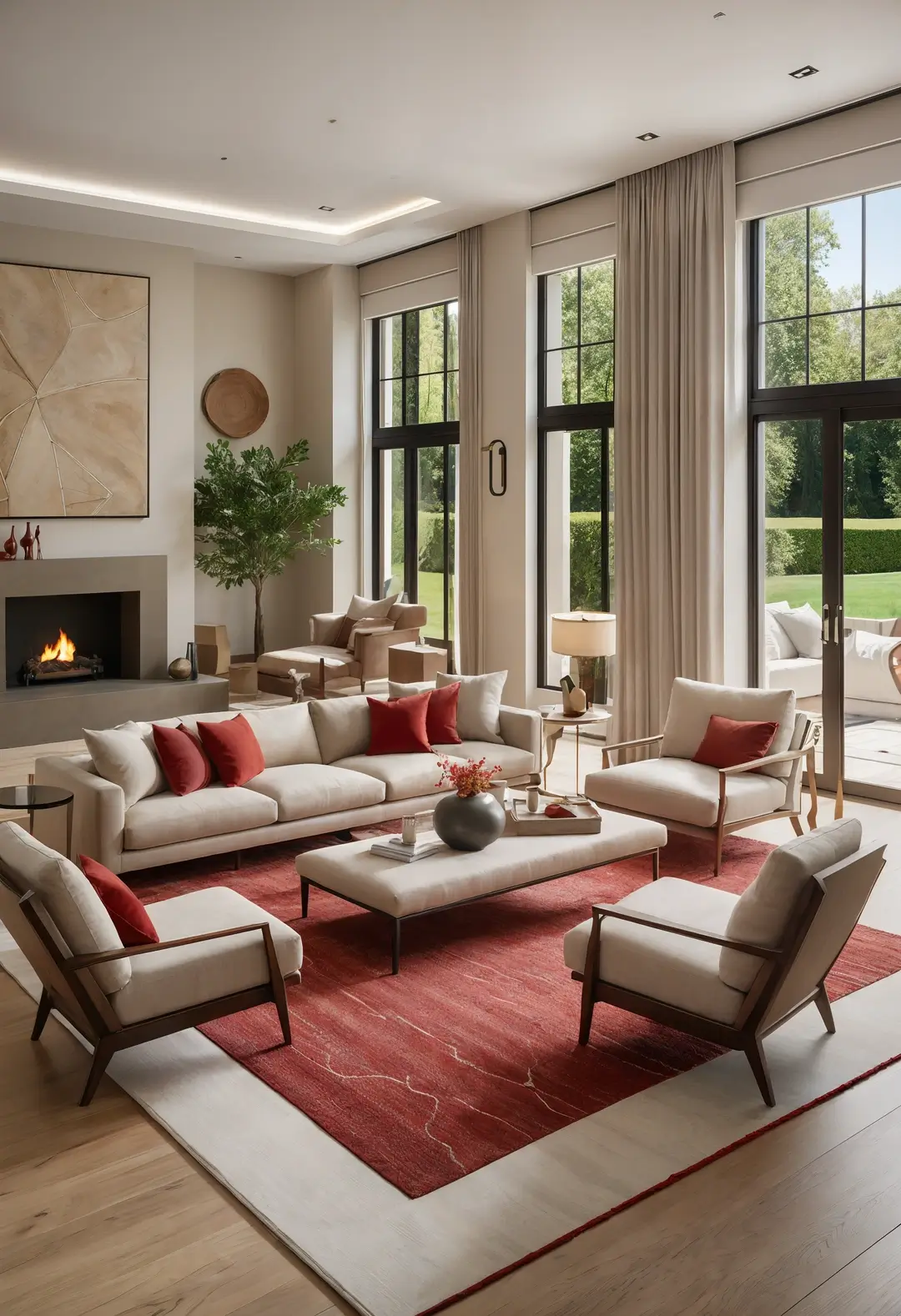
This dramatic approach often appeals to homeowners wanting contemporary, bold environments. Black furniture or accessories with red rugs typically create sophisticated contrast that feels both modern and timeless.
Design impact: The red-black combination often creates striking visual drama while maintaining elegant sophistication.
What makes this effective: Both colors often work together to create environments that feel intentionally designed and professionally sophisticated.
8. Earthy Tone Harmony
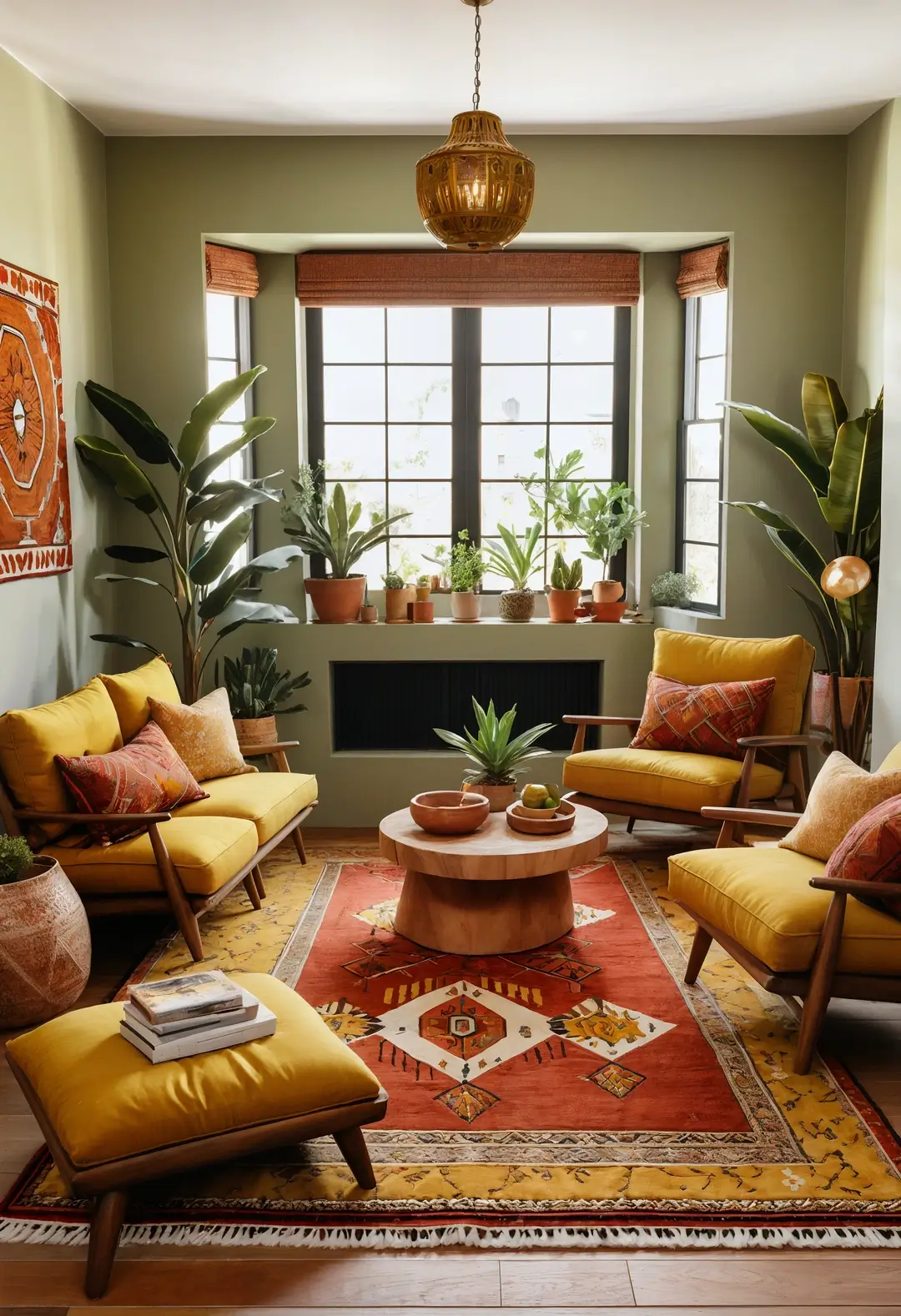
This organic approach often works well for homeowners drawn to natural, warm aesthetics. Olive green, mustard yellow, or terracotta elements with red rugs typically create grounded environments that feel both vibrant and natural.
Color relationship: These earth tones often share warm undertones with red, creating cohesive palettes that feel harmonious and inviting.
Material consideration: Natural materials like wood and clay often enhance this earthy aesthetic effectively.
9. Gallery Wall Integration
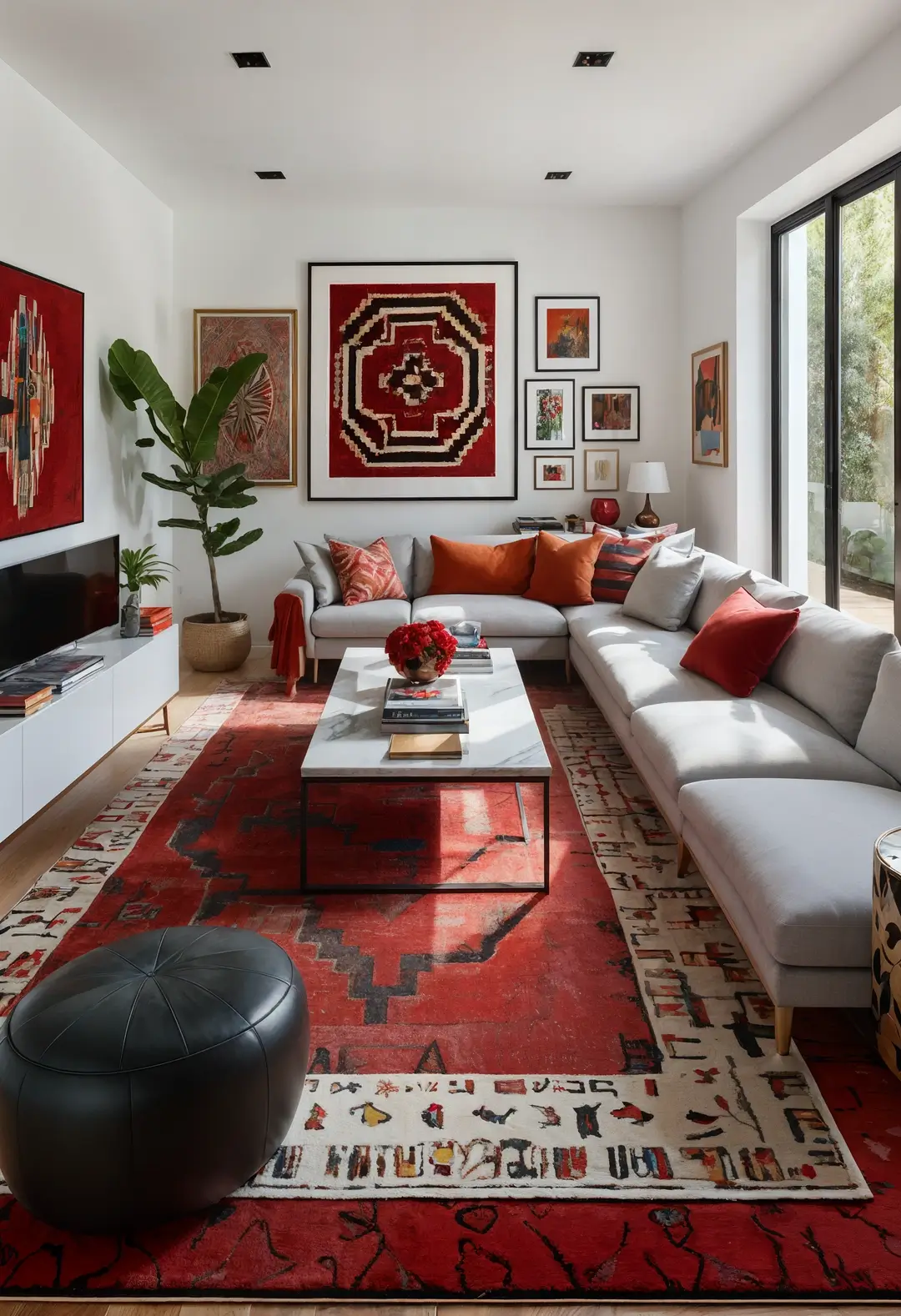
This artistic approach often appeals to homeowners who appreciate visual storytelling. Gallery walls above red rugs typically create connected design elements that enhance both the rug and the artwork.
Design strategy: Art pieces that complement or contrast with red tones often create compelling visual relationships throughout the space.
What enhances this style: Thoughtful curation often allows the rug and artwork to work together as unified design elements.
10. Layered Rug Technique
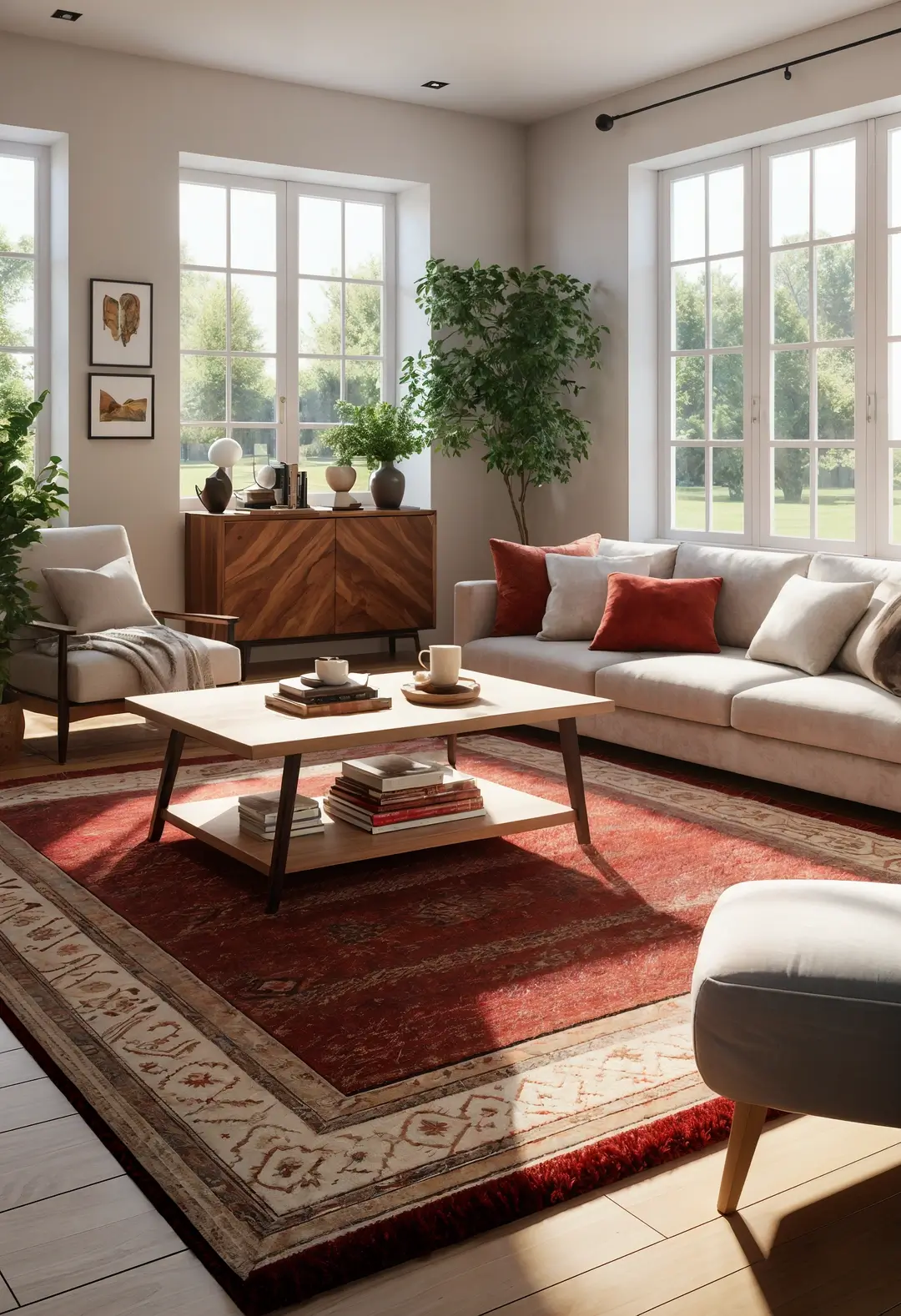
This textural approach often works well for homeowners seeking cozy, dimensional environments. Layering smaller rugs over red foundations typically adds depth while softening the overall visual impact.
Design consideration: Complementary colors and varied textures often create successful layering that feels intentional rather than chaotic.
Practical benefit: This technique often allows for adjustable comfort and style while protecting the primary rug investment.
11. White Furniture Contrast
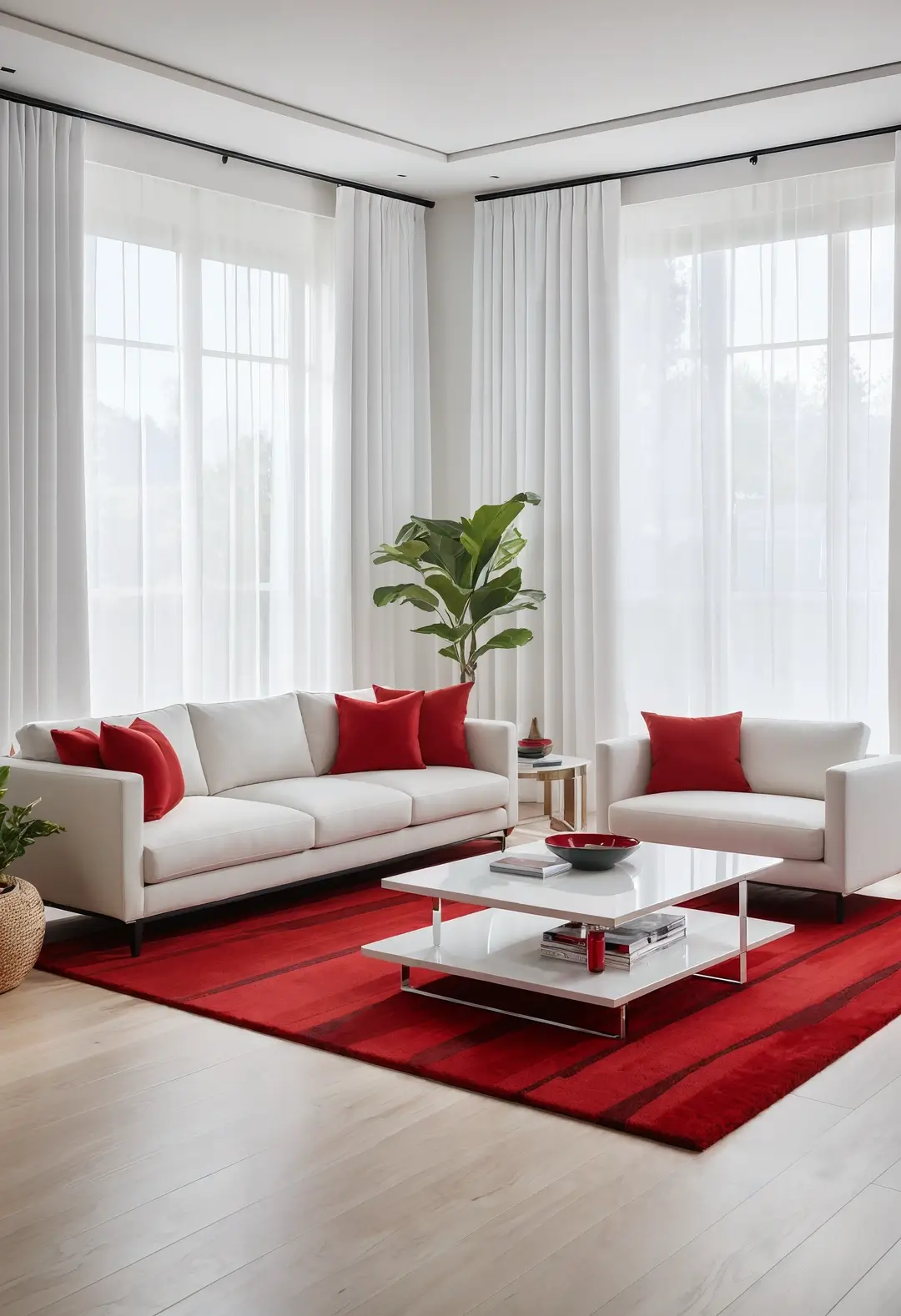
This fresh approach often appeals to homeowners wanting crisp, contemporary aesthetics. White furniture with red rugs typically creates clean contrast that feels both modern and energetic.
Design benefit: The combination often creates airy environments where the red rug provides necessary warmth and visual weight.
Color strategy: The stark contrast often allows both elements to appear more vibrant and impactful than they might individually.
12. Natural Wood Integration
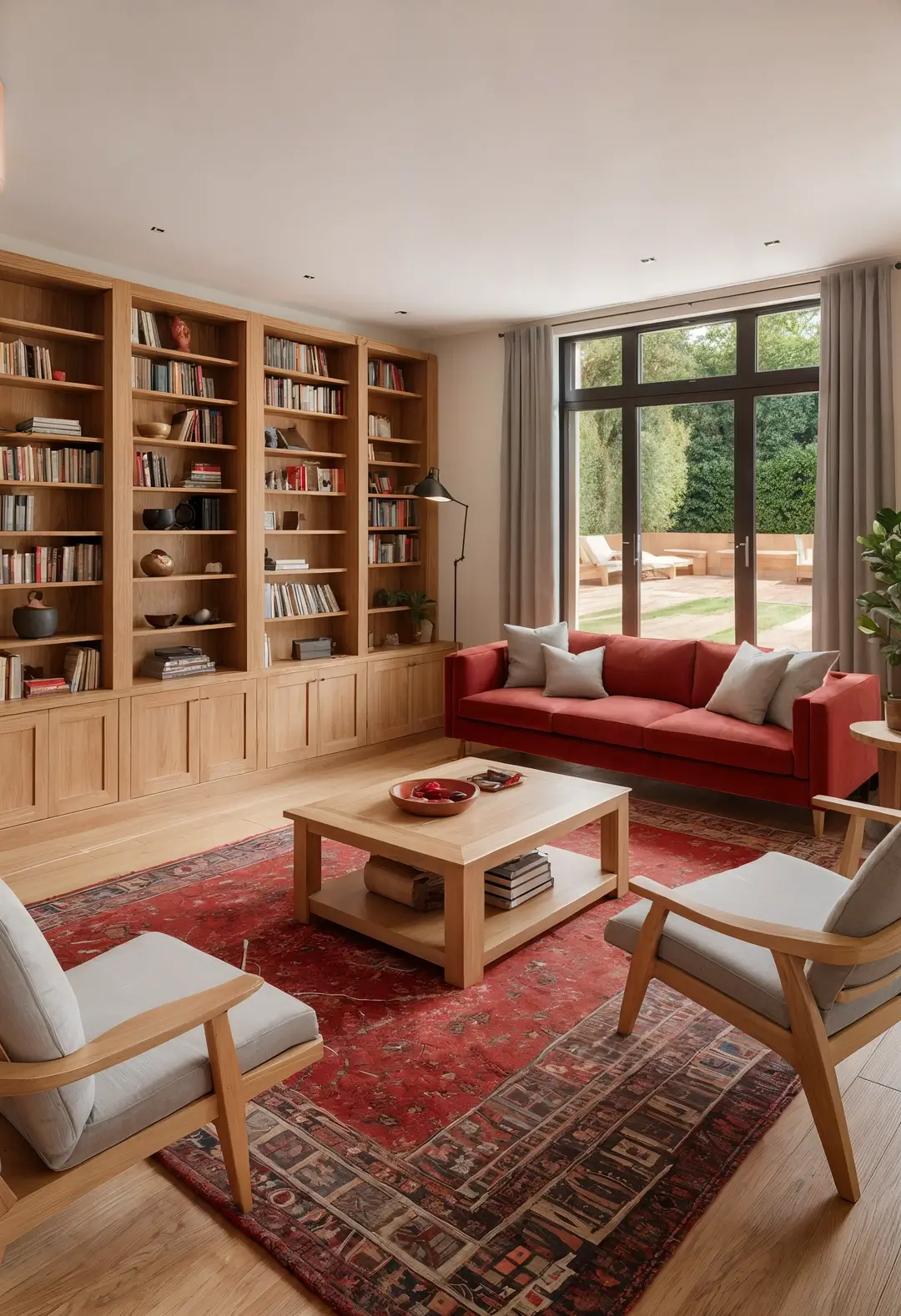
This organic approach often works well for homeowners appreciating warm, natural materials. Wood furniture in oak, pine, or walnut typically complements red rugs while adding textural variety and natural character.
Material harmony: Both elements often share warm undertones that create cohesive, inviting environments.
Design consideration: Different wood finishes often provide varied visual interest while maintaining the overall warm aesthetic.
13. Leather Furniture Pairing

This rich approach often appeals to homeowners seeking luxurious, textural environments. Brown or tan leather furniture with red rugs typically creates sophisticated layering that feels both comfortable and upscale.
Texture contrast: The smooth leather surface often provides compelling contrast against the rug’s woven texture.
Color harmony: Both materials often share warm, rich tones that create naturally sophisticated combinations.
14. Contemporary Sleek Styling
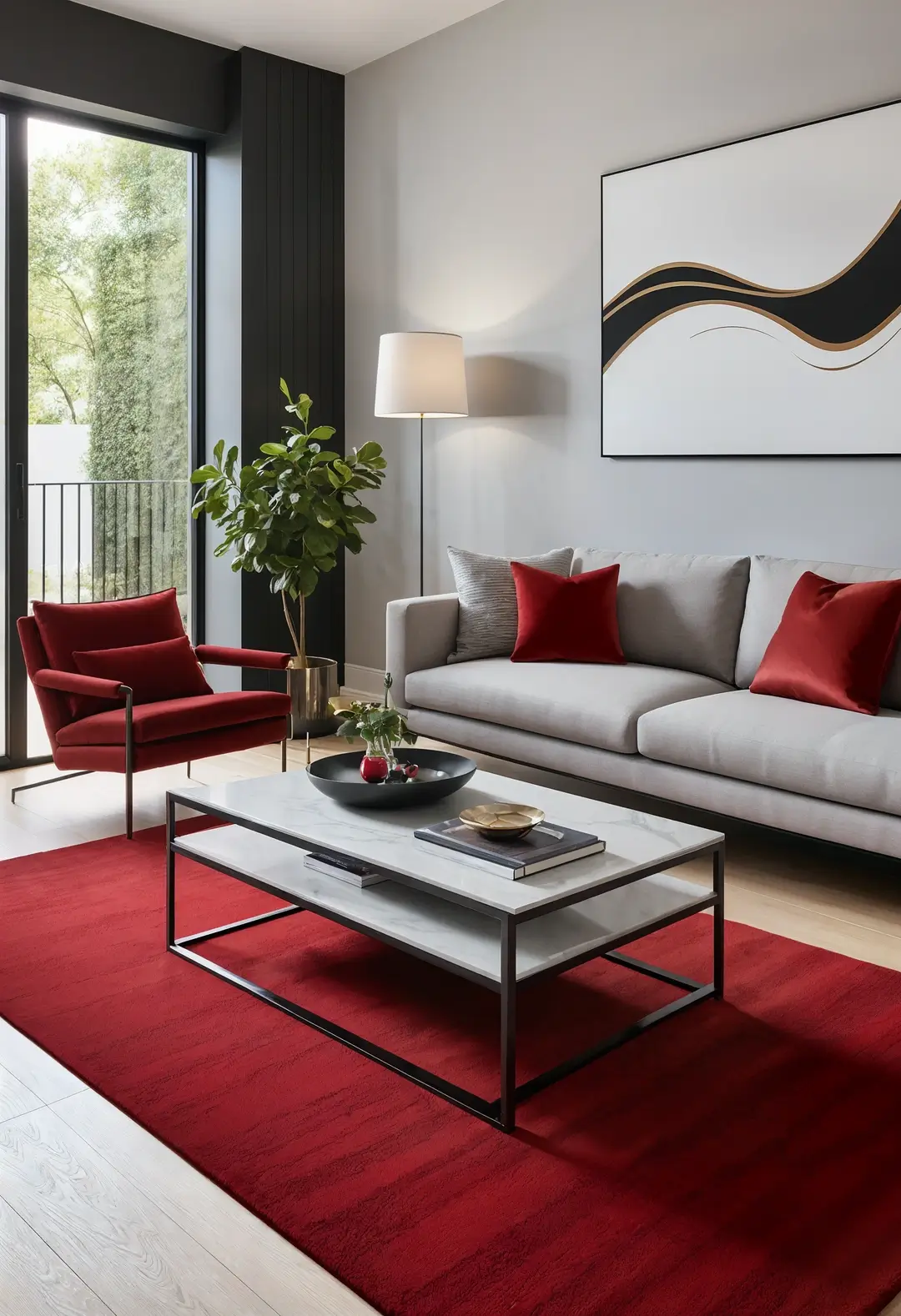
This modern approach often works well for homeowners preferring clean, sophisticated aesthetics. Contemporary furniture with minimalist forms typically allows red rugs to provide necessary color and warmth.
Design principle: Simple furniture lines often prevent competition with the rug’s bold color while maintaining contemporary sophistication.
What makes this effective: The combination often creates balanced environments that feel both current and timeless.
15. Multi-Texture Layering
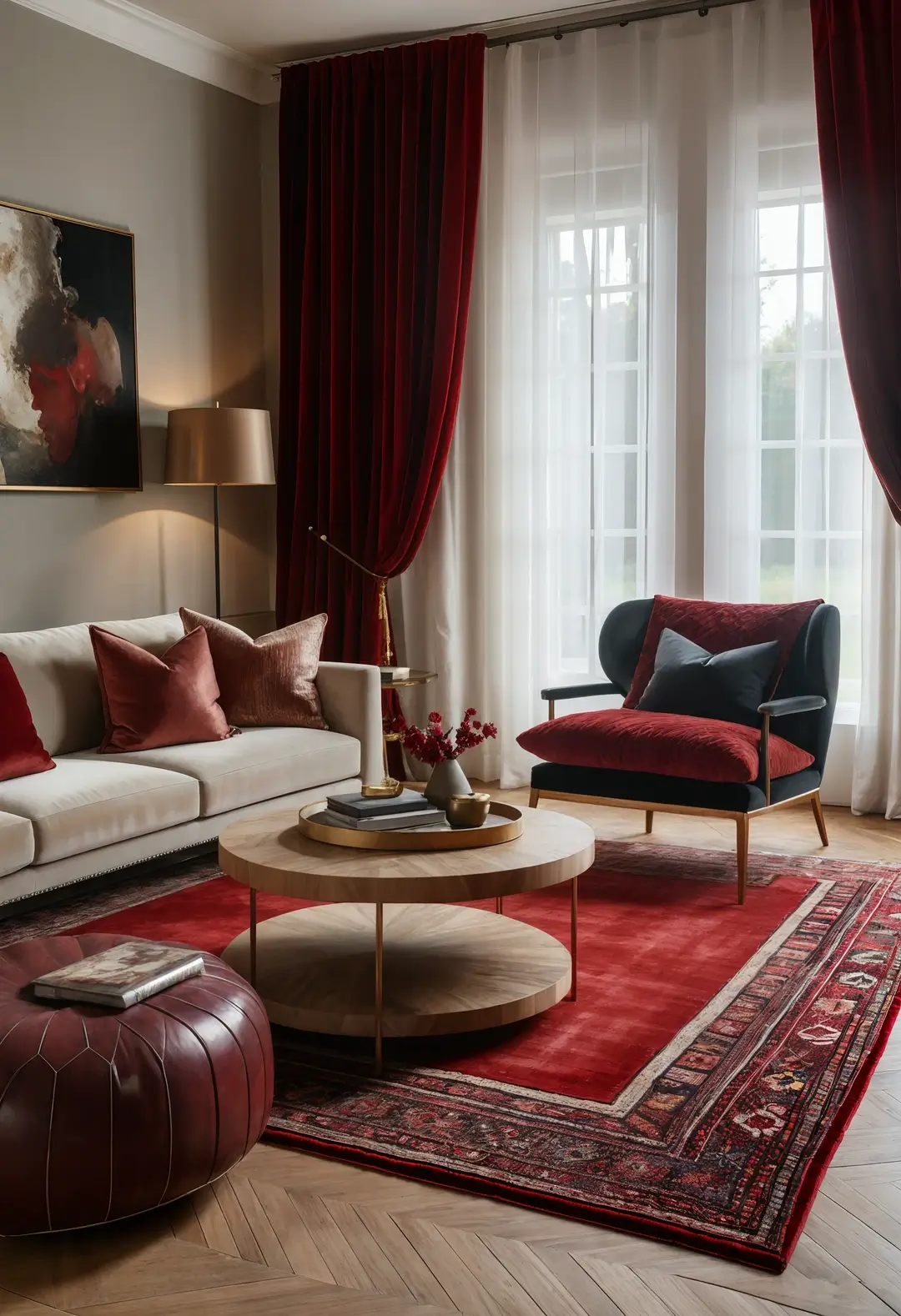
This sensory approach often appeals to homeowners who appreciate tactile variety. Combining velvet, linen, wool, and leather textures with red rugs typically creates rich, engaging environments.
Design benefit: Multiple textures often add visual and tactile interest while creating cozy, inviting atmospheres.
Practical consideration: Varied materials often provide different comfort levels and functional benefits throughout the space.
16. Zone Definition Strategy
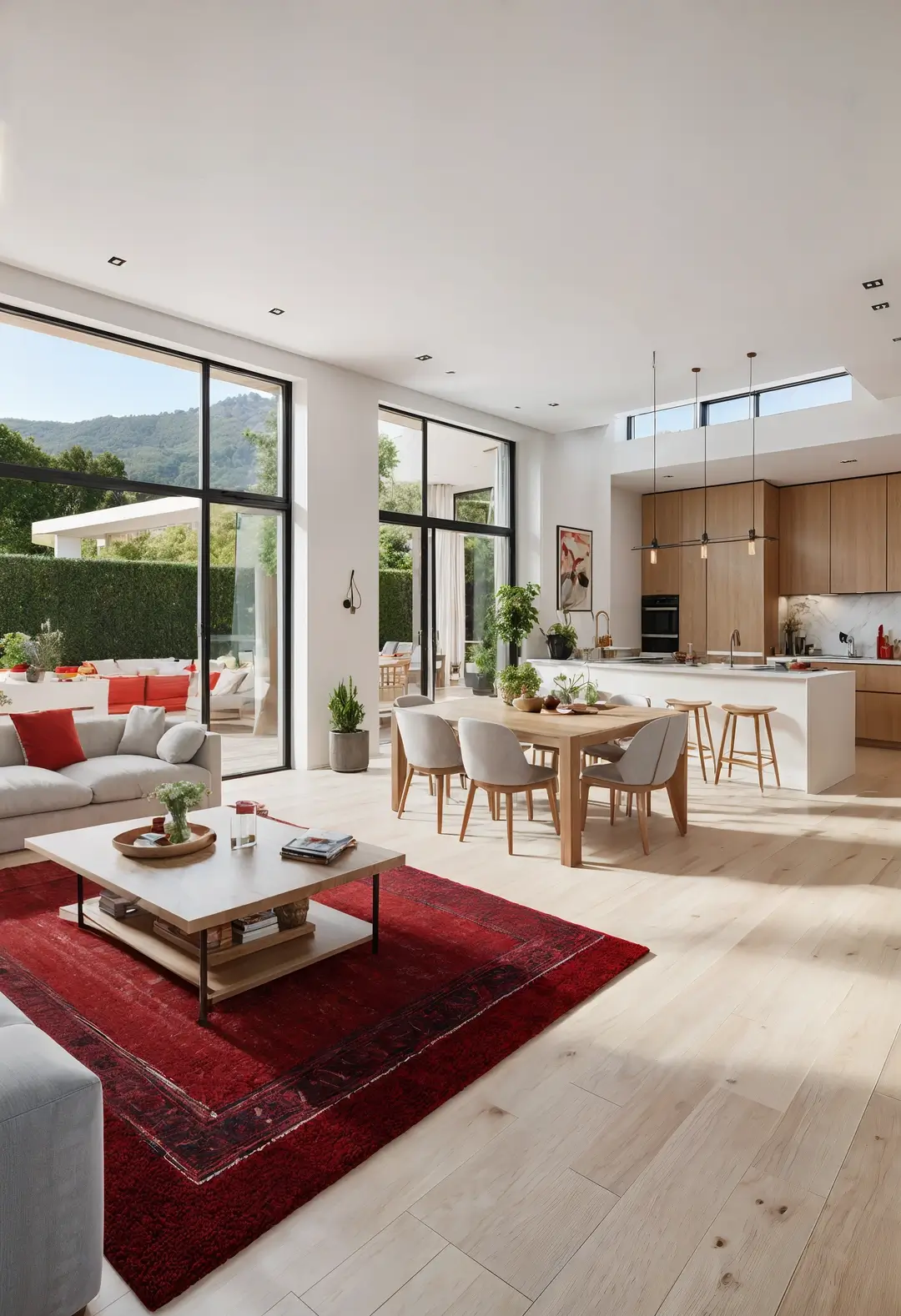
This functional approach often works well for homeowners with open-plan living areas. Using red rugs to define specific zones typically creates visual structure while maintaining overall design cohesion.
Design application: Strategic rug placement often helps distinguish seating areas from dining or work spaces effectively.
Practical benefit: This technique often provides organizational clarity in multi-functional environments.
17. Monochromatic Red Approach
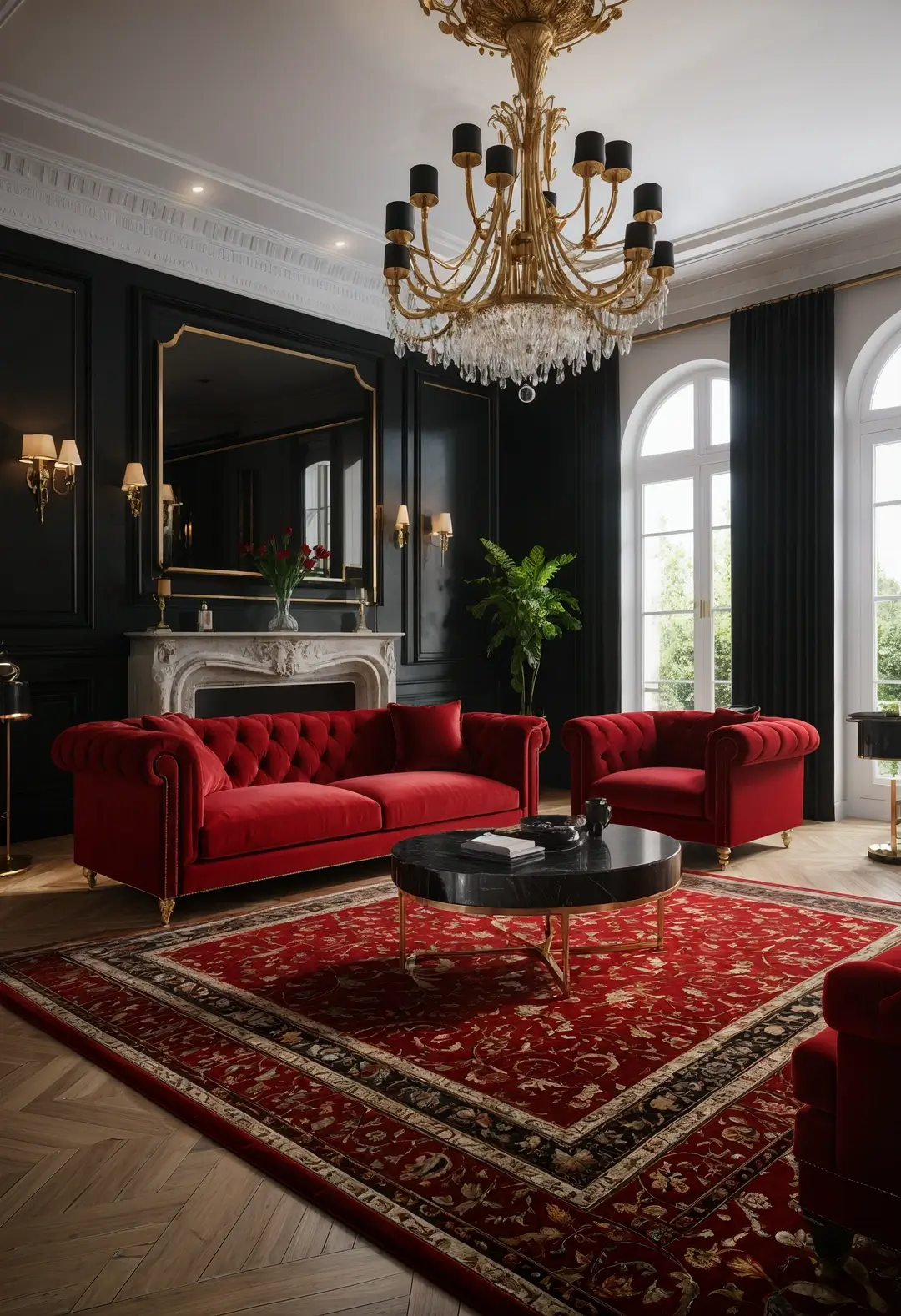
This bold strategy often appeals to homeowners wanting dramatic, cohesive environments. Combining red rugs with red furniture pieces typically creates rich, luxurious atmospheres that feel intentionally sophisticated.
Design balance: Varying red tones and textures often prevent monochromatic schemes from feeling overwhelming or monotonous.
Enhancement strategy: Neutral accessories often provide necessary visual breaks while maintaining the overall red theme.
18. Statement Lighting Integration
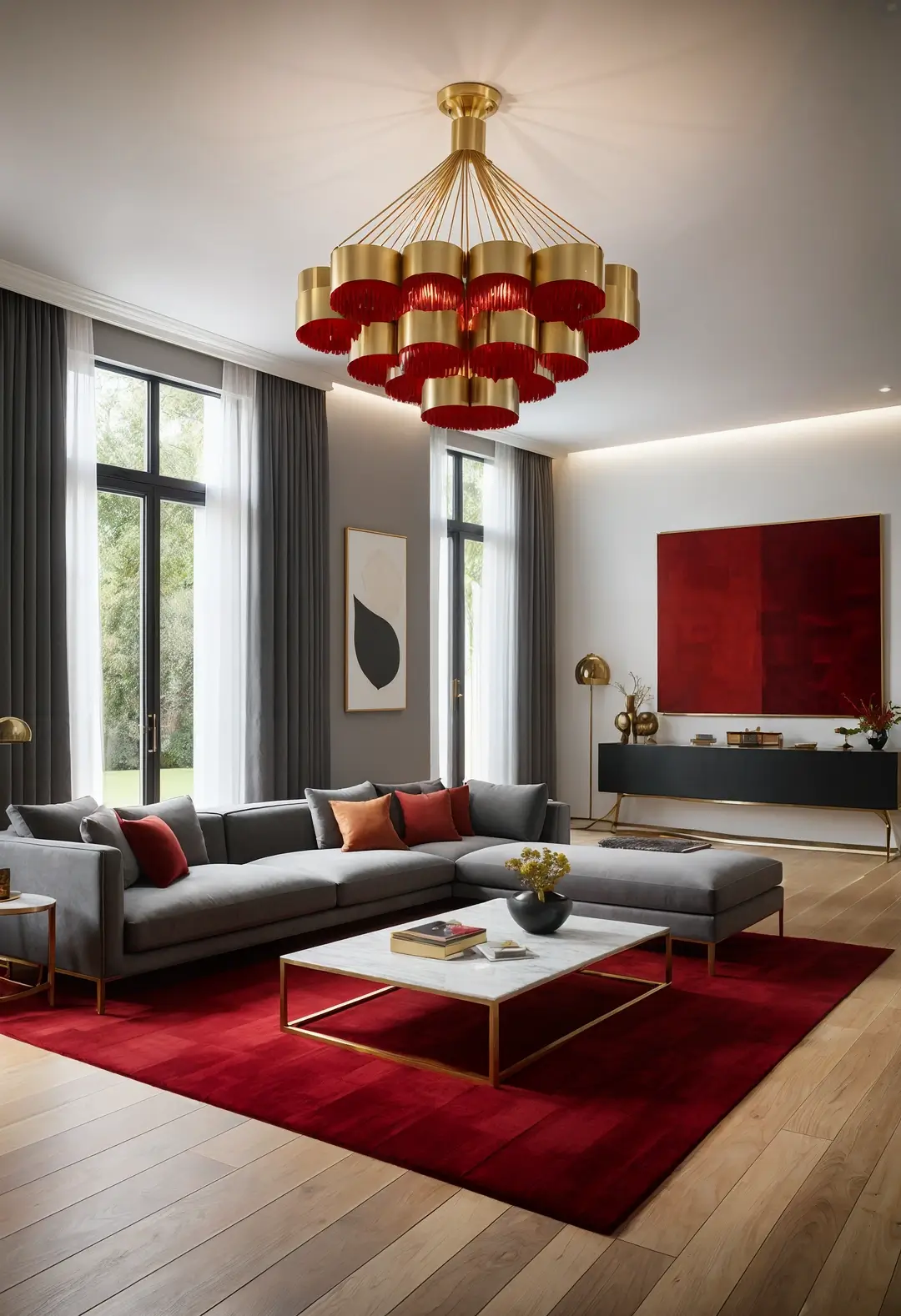
This illuminated approach often works well for homeowners wanting to enhance their rug’s impact. Distinctive chandeliers or pendant lights typically complement red rugs while adding architectural interest.
Design benefit: Proper lighting often enhances the rug’s color richness while creating overall atmospheric enhancement.
Style consideration: Light fixture styles often help establish the room’s overall design direction alongside the rug.
19. Patterned Fabric Mixing
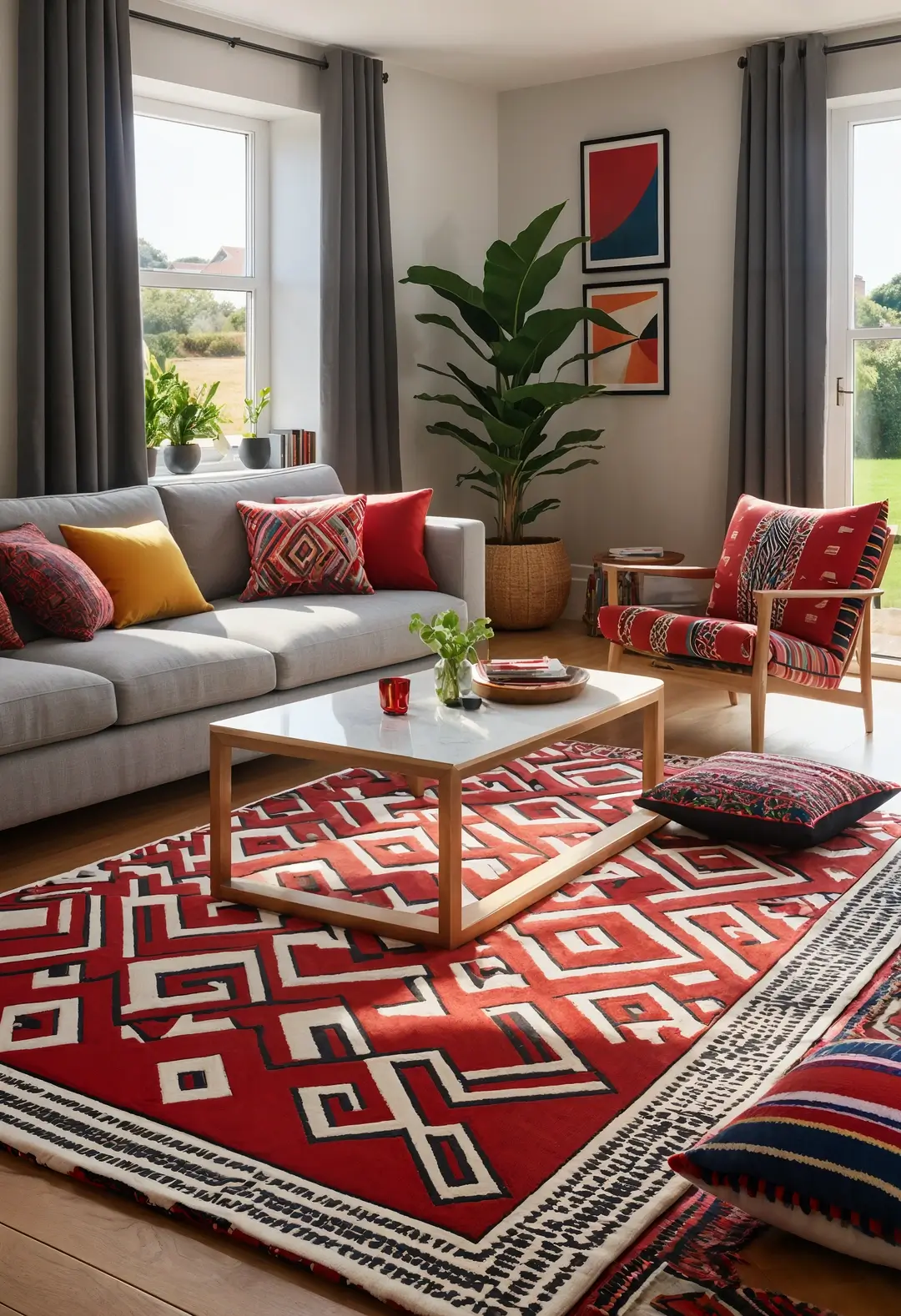
This layered approach often appeals to homeowners who enjoy visual complexity. Combining patterned textiles with red rugs typically creates dynamic environments when carefully coordinated.
Design skill: Successful pattern mixing often requires attention to scale and color relationships to maintain harmony.
What makes this effective: Complementary patterns often enhance rather than compete with the rug’s design elements.
20. Bohemian Style Foundation
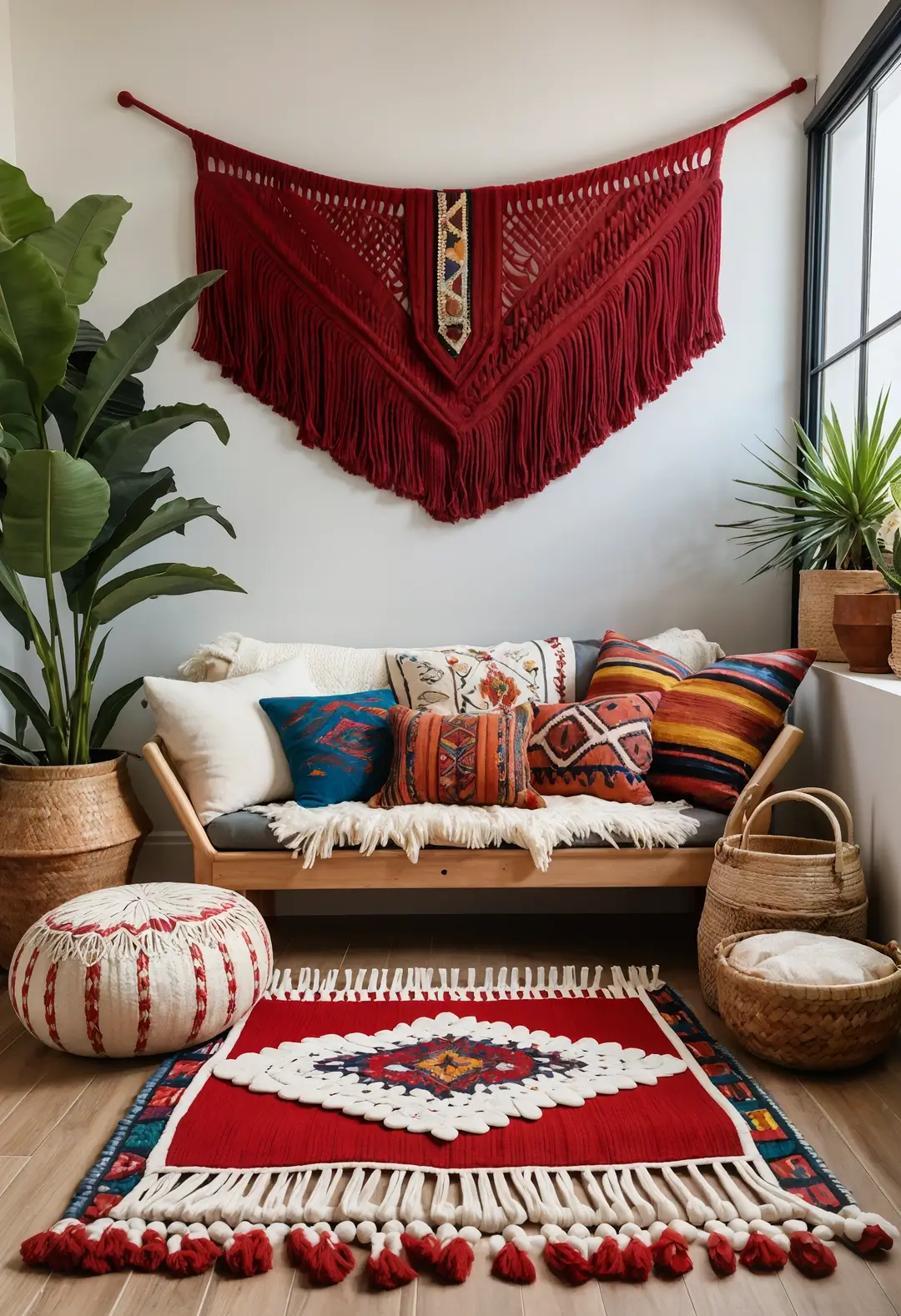
This eclectic approach often works well for homeowners appreciating global influences and relaxed aesthetics. Bohemian elements with red rugs typically create welcoming, artistic environments that celebrate color and texture.
Design principle: Multiple patterns and natural materials often work together when unified by warm color palettes.
Cultural consideration: This style often allows for authentic expression of diverse design influences and personal collections.
21. Living Plant Integration
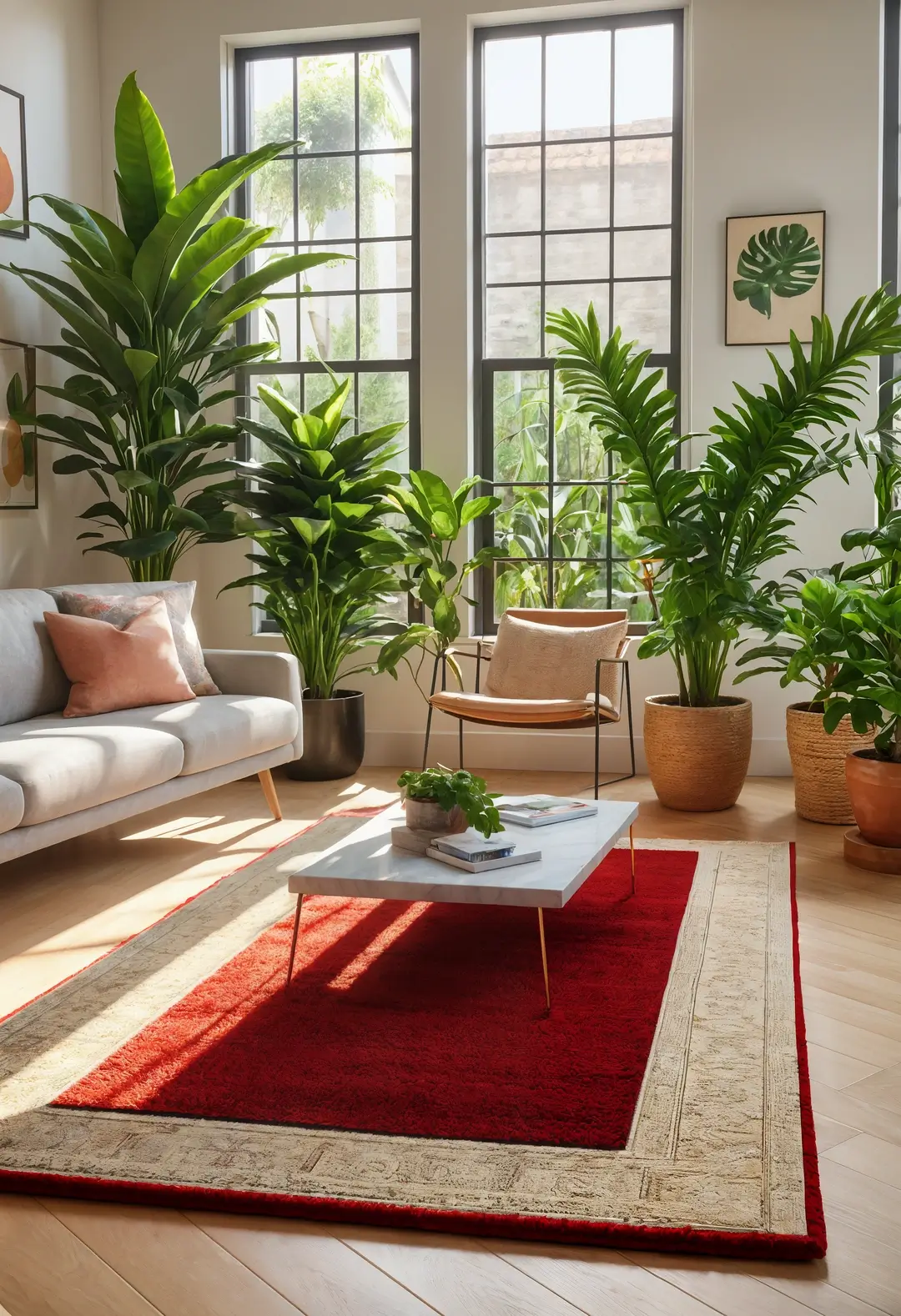
This organic approach often appeals to homeowners wanting to balance bold colors with natural elements. Plants with red rugs typically provide cooling contrast while adding life and freshness to the space.
Color benefit: Green foliage often creates natural complement to red tones while softening the overall visual intensity.
Practical consideration: Various plant sizes and varieties often add dimensional interest without overwhelming the rug’s prominence.
22. Luxury Textile Enhancement
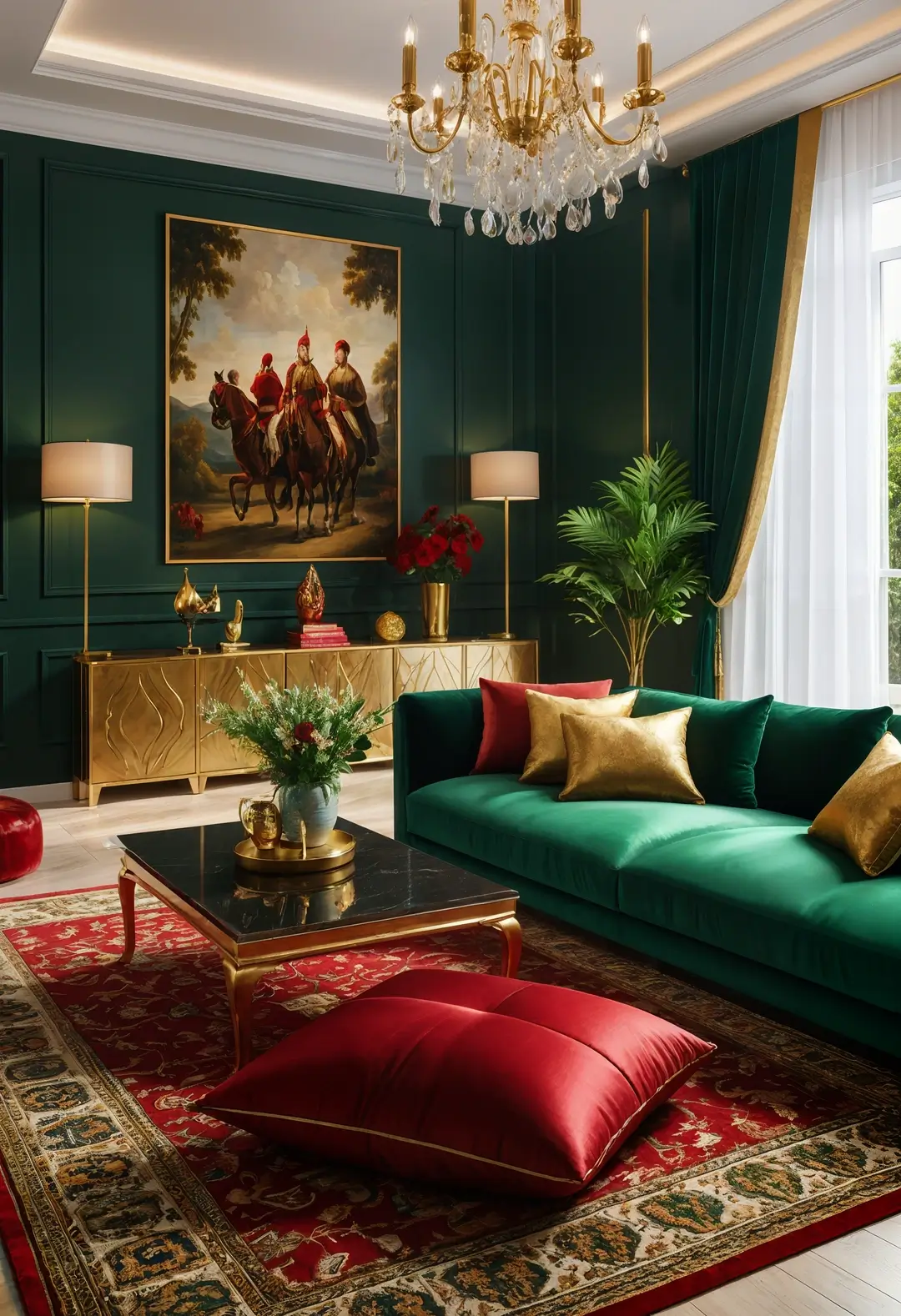
This opulent approach often works well for homeowners seeking sophisticated, rich environments. Silk or satin cushions in complementary colors typically elevate red rug settings while adding textural luxury.
Color strategy: Deep jewel tones often work particularly well with red foundations, creating cohesive luxury aesthetics.
Design application: Strategic placement of luxury textiles often enhances the overall sense of intentional sophistication.
23. Light Wood Balance
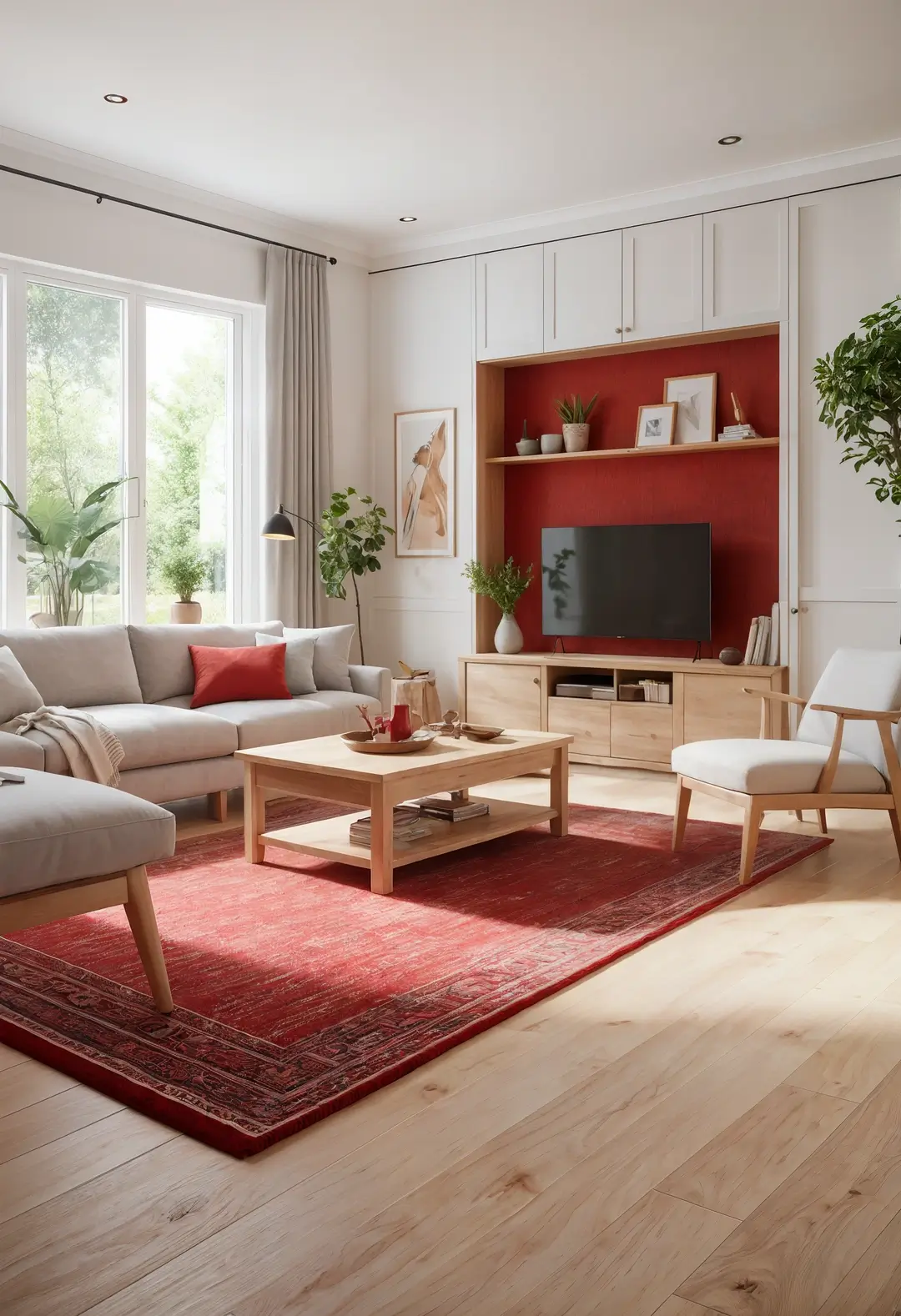
This airy approach often appeals to homeowners wanting to maintain brightness while incorporating bold colors. Light wood furniture typically provides visual balance against red rug intensity while maintaining warmth.
Design benefit: Pale wood tones often create contrast that makes both elements appear more distinctive and appealing.
Color relationship: The combination often creates environments that feel both energetic and serene.
24. Simplified Color Palette
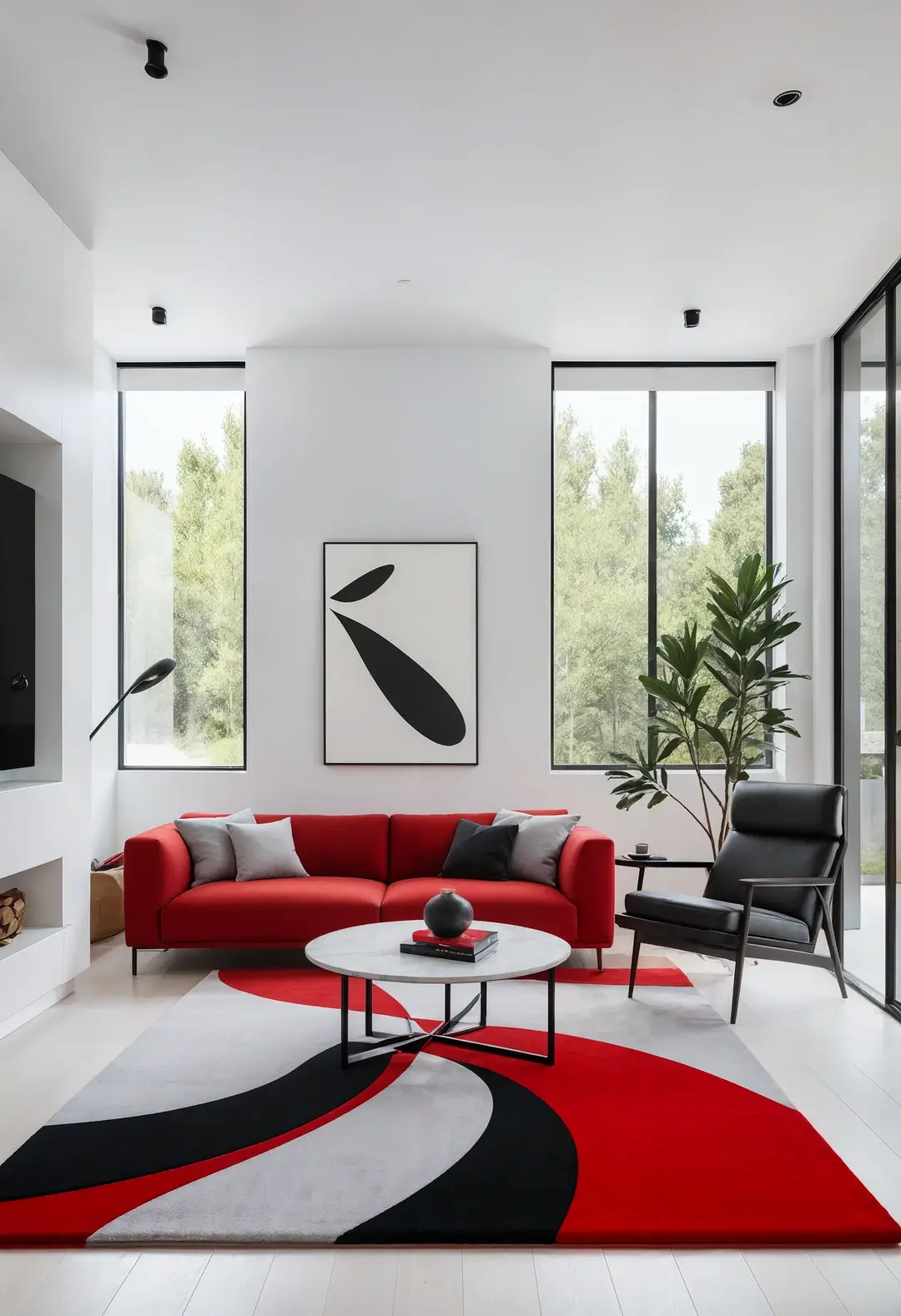
This restrained approach often works well for homeowners preferring modern, uncluttered aesthetics. Limiting additional colors to blacks, whites, or grays typically allows red rugs to serve as the primary color statement.
Design philosophy: Sometimes restraint often creates more impactful results than complex color schemes.
What makes this effective: The simplified approach often creates sophisticated environments where the rug becomes the natural focal point.
25. Whimsical Furniture Mixing
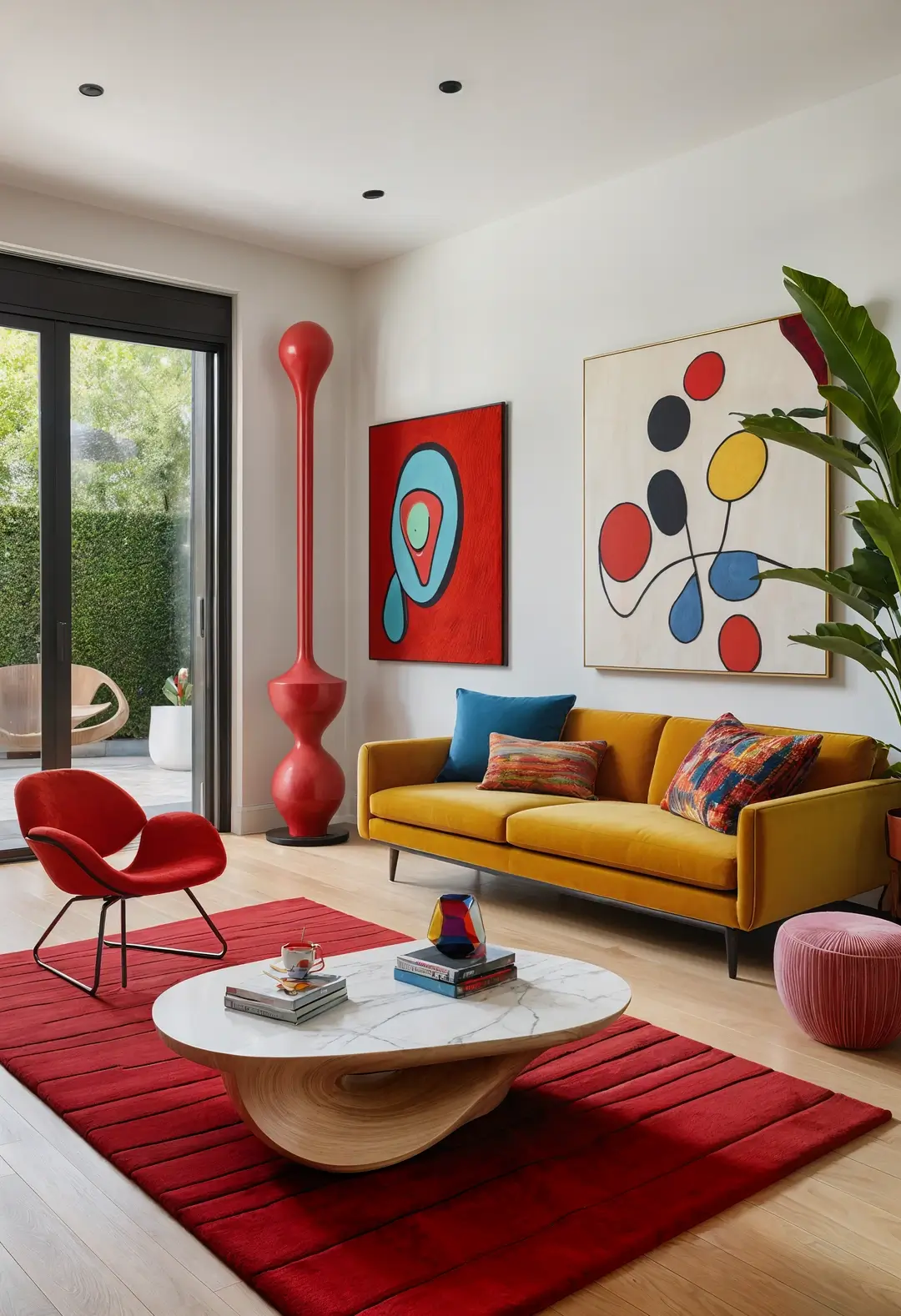
This playful approach often appeals to homeowners who appreciate unique, personality-filled spaces. Quirky or sculptural furniture with red rugs typically creates environments that feel both sophisticated and fun.
Design benefit: Unexpected furniture choices often enhance the rug’s bold character while creating memorable, personal spaces.
Balance consideration: Playful elements often work best when grounded by the rug’s substantial presence and rich color.
Working with Red Rugs Successfully
Through various projects, I’ve observed that successful red rug integration often depends on understanding the color’s powerful impact and balancing it appropriately with surrounding elements. Red rugs work best when their bold nature is respected while being incorporated into livable, functional environments.
The key to effective red rug styling often lies in choosing complementary elements that enhance rather than compete with the rug’s natural drama. Whether you prefer minimalist sophistication or richly layered environments, red rugs typically provide the kind of immediate impact and long-term visual interest that can transform ordinary living rooms into memorable, welcoming spaces.
Remember: For any electrical work, structural changes, or built-in installations mentioned in these ideas, always consult with licensed professionals to ensure proper installation and code compliance.

